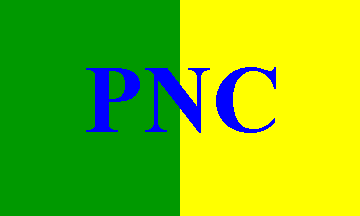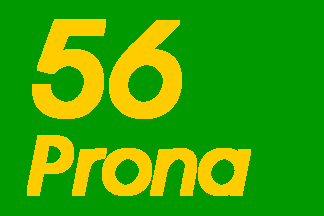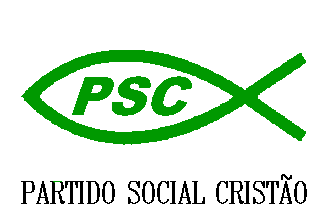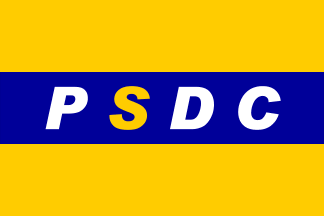![[Partido dos Aposentados da Nação (Brazil)]](../images/b/br}pan.gif) image by
Jorge Candeias
image by
Jorge Candeias
Last modified: 2013-12-13 by ian macdonald
Keywords: brazil | amor |
Links: FOTW homepage |
search |
disclaimer and copyright |
write us |
mirrors
A small party with little electoral expression but some media
coverage. The image is based on one I found in their website,
suggesting that the party flag is white with the party logo. The logo consists of a green
lozenge partially covered to the right by an orange ellipse. The initials are placed over this
geometrical pattern in thick blue italic characters, occupying the area of
the lozenge, and the party name in full is written in small italics to its
right.
Jorge Candeias, 9 May 1999
![Partido Federalista (Brazil)]](../images/b/br}pf.gif) image by
Joseph McMillan
image by
Joseph McMillan
The Federalist Party wants a
more federal structure for Brazil, transferring more power from the central
government to the states.
Jorge Candeias, 9 May 1999
The Federalist Party's new
flag is a totally white rectangle with a four color tree at the center. The tree's colors are:
The PF is not registered with the Brazilian
Supreme Electoral Tribunal and therefore had no candidates for election in the 2002 campaign.
Joseph McMillan, 5 November 2002
According to Article 2 of the party statute the flag is green and yellow, with two green stripes, the upper inscribed
Partido Geral dos Trabalhadores in blue and the lower O Partido da Gente
in blue, the yellow stripe with the inscription PGT 30 in blue, with the
symbol of the PGT in white outlined blue diagonally over the letter G. The symbol includes a tool combining a ballpoint pen with its
point over the lower part of the letter P and a wrench with its mouth on the upper part of the T.
The PGT failed to elect any federal deputies or senators in 2002.
Joseph McMillan, 5 November 2002
![[Partido Humanista (Brazil)]](../images/b/br}ph.gif) image by
Guillermo Tell Aveledo
image by
Guillermo Tell Aveledo
Not represented in Congress.
You can see images of flags at the party's website.
Click Galeria de Fotos.
Francisco Santos, 24 April 2003
The PHS flag is definitely official, as it is described in PHS party
documentation and illustrated at the
party's official
website.
Joseph McMillan, 25 April 2003
The National Mobilization Party usually goes to
elections preaching ideals of freedom for Brazil. Though not being, as far as I know, a
regionalist party, it is based in the state of Minas Gerais and its symbols are based
on the symbols of Minas, which in turn were based on the symbols adopted
by the rebellion known as the Inconfidência Mineira."
The flag is therefore white with a red triangle.
Jorge Candeias, 29 April 1999
According to article 3 of the party statute, "The flag is white with a red equilateral triangle on the center with
the inscription in base in black, "PMN" (outside the polygon)." The PMN elected one deputy in the 2002 elections.
Joseph McMillan, 5 November 2002
 image by Guillermo Tell Aveledo
image by Guillermo Tell Aveledo
The National Consumers Party is (still?) not a registered party, but has a
web presence, in which it talks about the defense of the consumer's rights as
its main objective, and with a prominent logo featuring a flag: a green-yellow
vertical bicolor with the party's initials in blue overall, in an
evident alusion to the national flag.
Jorge Candeias, 29 April 1999
No seats in Congress.
Joseph McMillan, 16 April 2001
This flag belongs to a party that
nearly vanished from the Brazilian political scene. The PRN (Party of
National Renewal) was the party behind former President Collor
de Mello, who got impeached for corruption some years ago. The flag is
white with black initials below a logo that could be described as an
outlined graffitti version of the brazilian flag: a dark green rectangle, a
yellow lozenge, and a blue circle.
Jorge Candeias, 29 April 1999
Images of the flag at the party website.
Francisco Santos, 24 April 2003
 image by
Guillermo Tell Aveledo
image by
Guillermo Tell Aveledo
PRONA elected six candidates to the Chamber of Deputies in 2002.
Joseph McMillan, 5 November 2002
 image by
Guillermo Tell Aveledo
image by
Guillermo Tell Aveledo
Article 2 of the party statute defines the flag as either "a green or white field and the fish logo in green
or white." It doesn't mention the name as shown above. The PSC elected a single deputy in the 2002 elections.
Joseph McMillan, 5 November 2002
 image by
Jorge Candeias, 4 August 2005
image by
Jorge Candeias, 4 August 2005
The official norms for manufacture of the PSDC flag at
the party website give dimensions of
60 x 100, 90 x 150 or 120 x 200 cm. The flag has two yellow stripes lengthwise at the top and bottom and a blue central stripe, all equal.
On the center the initials PSDC with all the letters white except the "S" which is yellow , all in Arial bold italic letters 14, 21, or 28 cm high
depending on the size of the flag. The PSDC elected one deputy in 2002.
Joseph McMillan, 5 November 2002
A green party without a green flag and without the almighty sunflower of
the international ecological political movement. Instead, the flag of this
party is white with the party logo centered. The logo is also in the nature of
graffitti, with a green "V" within a green circle. The
source for this image is a photograph from one of the party's websites, so
the accuracy (in terms of usage) is high. Carlos Noronha confirms it. I find it
interesting that this flag and arrangement reminds me of the international
banner of peace.
Jorge Candeias, 29 April 1999
Article 4 of the party statute provides for "a white flag with the "V" inside a circle, both green."
Joseph McMillan, 5 November 2002
The Greens elected five federal
deputies in the 2002 elections.
Joseph McMillan, 5 November 2002
![[Suggested New Flag of Brazil]](../images/b/br!amor.gif) image by
António Martins-Tuválkin
and
Joe McMillan, 26 April 2009
image by
António Martins-Tuválkin
and
Joe McMillan, 26 April 2009
This one is unbelievable: in Brazil, a group of citizens is lobbying
to add "love" to the national motto "order and progress!" At their
site [no longer available-Ed.] "Bota amor nessa bandeira!" ("Put some love on that flag!"),
a photo of a real flag (i.e., made of cloth) can be seen--which could
be considered illegal, since the Brazilian constitution explicitly forbids
any changes to (or variants from) the national flag. (I wonder
if the state flags of Mato Grosso or
Ceará would qualify).
António Martins, 22 November 1998
The Wikipedia article on
Auguste Comte presents similar symbolism in a paragraph at
http://en.wikipedia.org/wiki/Flag_of_Brazil:
"The motto _Ordem e
Progresso_ ("Order and Progress") in the flag of Brazil is inspired by Auguste
Comte's motto of positivism: _L'amour pour principe et l'ordre pour base; le
progrès pour but_ ("Love as a principle and order as the basis; Progress as the
goal"). It was inserted because several of the people involved in the military
coup d'état that deposed the monarchy and proclaimed Brazil a republic were
followers of the ideas of Comte."
After reading the full quote of the Comte's motto, the proposal to include
the word "love" in the flag seems much more sensible. The reference
for this quote is from his work titled "Système de politique positive", first
issued in 1852. There seems to be the Positivist Church of Brazil,
http://www.igrejapositivistabrasil.org.br/english/ using this motto as well,
apparently venerating the humanist founding fathers of Brazil who were obviously
influenced by Comte. They seem to have a story on how the well known Brazilian
flag came to be. I am not sure if the movement for "Amor" has any connection to
this church.
Željko
Heimer, 1 April 2009
A full quote, of which I have not able to track the source, is:
"L’amour
pour principe, l’ordre pour base, et le progrès pour but; tel est, d’après ce
long discours préliminaire, le caractère fondamental du régime définitif que le
positivisme vient inaugurer." ("Love as a principle and order as the basis, and
progress as the goal; here is, following this long preliminary speech, the
fundamental feature of the definitive regime that positivism comes to
inaugurate.")
The motto "L’amour pour principe, l’ordre pour base, et le
progrès pour but" appears on the front page of volume II ("Tome deuxième,
contenant la statistique sociale ou le traité abstrait de l'ordre humain" -
Volume II, including the social statistic or the abstract treaty of the human
order). Page 65 of this volume contains another famous quote: "[...] on doit
toujours appliquer la formule sacrée des positivistes: l'amour pour principe,
l'Ordre pour base, et le Progrès pour but". (We should always apply the sacred
formula of the positivists: [...])
This seems to indicate that the motto
was originally quoted, provided that the quote given above is accurate, in
volume I of the book, published in 1851.
The full title of the book is: "Système
de politique positive, ou Traité de Sociologie, instituant la religion de
l'humanity" ("System of positive politics or Treaty of Sociology, establishing
the religion of humanity")
Ivan Sache, 10 April 2009